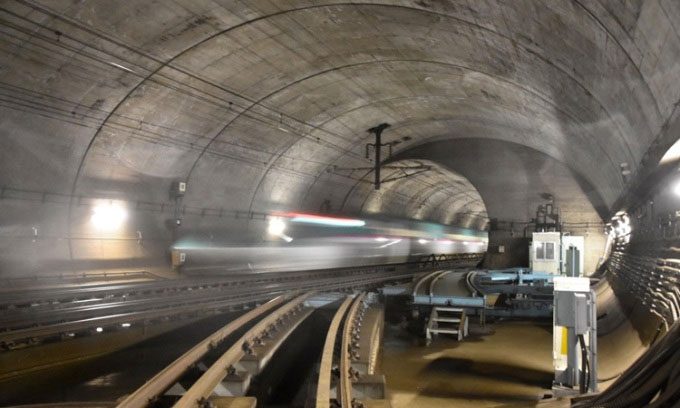The Seikan Tunnel, with its 23.3 km section submerged beneath the Tsugaru Strait, accommodates 50 passenger and freight trains daily.
Located in Japan, the Seikan Tunnel is the longest tunnel that includes an underwater section, with a total length of 53.85 km, of which approximately 23.3 km lies beneath the seabed. This underwater segment reaches a depth of 100 m below the Tsugaru Strait, making the Seikan Tunnel the second largest railway tunnel in the world, surpassed only by the Gotthard Base Tunnel in the Swiss Alps. However, the longest railway tunnel in Switzerland traverses mountains rather than the seabed, according to IFL Science.

A Shinkansen train passing through the Seikan Tunnel. (Photo: Japan Times).
The Channel Tunnel between France and the UK holds the title of the longest underwater tunnel in the world, with a submerged section of 38 km; however, the Seikan Tunnel (including its non-submerged sections) is longer and deeper. This engineering marvel took decades to complete.
In 1954, Typhoon Marie struck Japan, resulting in the sinking of five ferries in the Tsugaru Strait. The disaster claimed the lives of 1,430 people. This maritime tragedy prompted Japan to seek a safer solution for transporting large volumes of traffic across the Tsugaru Strait. In 1955, the Japanese National Railways conducted studies to assess the feasibility of a tunnel beneath the strait. Construction officially began in 1964 but faced numerous setbacks. It wasn’t until 1971 that the main construction of the Seikan Tunnel commenced. The tunnel was completed in 1985 and opened to the public in 1988. The construction process also included two underwater stations, each located near the shore of an island.
The total construction cost of the tunnel was approximately $4.6 billion. However, the Seikan Tunnel operates very efficiently, with an estimated 50 trains passing through each day, including freight and passenger services. It even accommodates Japan’s Shinkansen bullet trains, which can reach speeds of up to 320 km/h.
The Seikan Tunnel allows passengers to travel from Tokyo to Hakodate, one of the major cities on Hokkaido Island, via the route known as Hokkaido Shinkansen. The journey through the Seikan Tunnel takes over 4 hours. By 2030, Japan hopes to extend this route to Sapporo, the capital of Hokkaido Prefecture, with an anticipated travel time of 5 hours.


















































